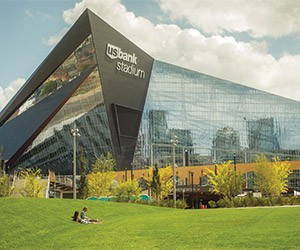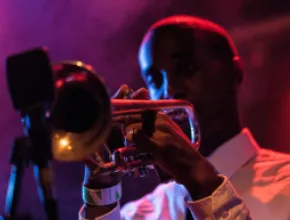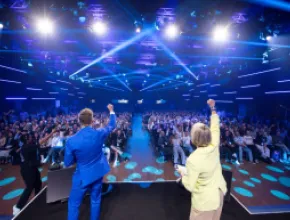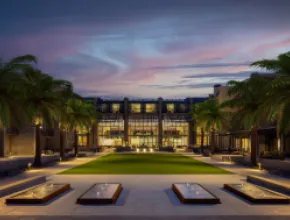The Minneapolis Metro area is seeing a wave of growth that is not showing signs of slowing down.
“Minneapolis is in the middle of a major transformation, which is making the city a stronger destination both for meetings and for leisure travel,” explained Matt Laible, director of PR and communications for Meet Minneapolis. “We’re calling this transformation ‘The Minneapolis Big Build,’ and it includes major new facilities, green spaces and public amenities.”
At the forefront of all that growth is U.S. Bank Stadium, which opened last summer. Not only is the stadium the new home of the NFL’s Minnesota Vikings, but along with the city it will be host to Super Bowl LII and the 2019 NCAA Men’s Final Four tournament.
Along with the new U.S. Bank Stadium, the city is also in the middle of a hotel boom with 1,100 new rooms added in the past year, including the Radisson RED Minneapolis and AC Hotel Minneapolis Downtown, and several projects are still underway. Other developments downtown include Nicollet Mall, Commons Park and the Minneapolis Sculpture Garden.
“Nicollet Mall, our main street downtown, is in the final year of a complete redesign and reconstruction,” Laible said. “It will be substantially complete later this year, and will be a more inviting, greener place for shopping and dining.”
Minneapolis
In addition to all the new development, the Twin Cities metro area is full of venues that highlight the region’s history and culture.
Along the banks of the Mississippi sits the Mill City Museum, located on the site that was once the Washburn A Mill, the world’s largest flour mill. An explosion at the mill in 1878 destroyed the building and the surrounding riverfront area, but the mill was rebuilt in 1880 and became the largest and most technically advanced mill in the world. As the need for the mill diminished, it closed in 1965, and in 1991 the vacant building was destroyed by a fire. In 2003, the Mill City Museum opened to showcase the importance that flour milling and other industries that used water power had on the growth of Minneapolis.
The museum’s design combines relics of the building’s past with brick, wood and steel for a modern industrial feel. The 10,000-square-foot courtyard is surrounded by brick masonry walls and can accommodate 500 guests. Inside, there is the Mill Commons and Rail Corridor space, as well as three conference rooms that can be used for meetings, lectures and receptions.
First opened in 1971 and expanded in 2005, the Walker Art Center campus completed additional renovations last year. The museum is home to contemporary visual arts and design exhibitions and features dance, theater and music performances, film screenings, lectures and classes. There are 11 exhibition galleries, a cinema, theater, indoor lounges, outdoor terraces and a cafe, bar and restaurant, many of which can be used for private events.
The recent transformation included a new main entrance, outdoor plaza and lobby as well as new artwork. In June, the new Wurtele Upper Garden will be complete and the Minneapolis Sculpture Garden, which houses the city’s iconic Spoonbridge and Cherry, a fountain-sculpture by Claes Oldenburg and Coosje van Bruggen, will reopen.
The Minneapolis Sculpture Garden, a joint project between the Walker and the Minneapolis Park & Recreation Board, is an 11-acre public space currently across the street from the Walker building, but the redevelopment will connect the Sculpture Garden and the Art Center, making it one unified space.
PageBreak
Once the lavish home to Swan Turnblad, the owner and publisher of the largest Swedish-language newspaper in the U.S., the Turnblad Mansion, built in 1908, is now the American Swedish Institute. The museum, which also includes the adjoining Nelson Cultural Center, is dedicated to sharing the history and culture of Sweden and Swedish-Americans, and the role both played in the Minneapolis area.
“The American Swedish Institute includes both a historic mansion as well as a modern events facility,” Laible said.
The complex blends the historic mansion outfitted with stained glass windows, with the contemporary Nelson Cultural Center. Groups can utilize both spaces.
Saint Paul
Often thought of as Minneapolis’ smaller, quainter counterpart, Saint Paul mixes history with modernity and charm.
Jane Lewis, Visit Saint Paul’s vice president of convention sales, describes Saint Paul as “a hip-charming city that is walkable and clean with a collection of urban parks which makes attendees feel safe and at home.”
Lewis continued, “We have the state’s only InterContinental Hotel property, the historic Saint Paul Hotel, the brand-new Hyatt Place, Hampton Inn & Suites and other top hotels.”
Situated near both the Landmark Center cultural space for the arts and the Saint Paul RiverCentre, which includes more than 64,000 square feet of exhibit space, the Roy Wilkins Auditorium and Xcel Energy Center arena, is the Ordway Center for the Performing Arts. While the other venues offer ample meeting and exhibit space, the Ordway features striking architecture and views of adjacent Rice Park and downtown. The center opened in 1985 and has hosted numerous theater and dance productions as well as world-music and vocal artists in its Music Theater and Concert Hall.
The Music Theater, which seats 1,910, and the Concert Hall, with a capacity for 1,085, are available for rent, while the atrium, lobby and two rehearsal halls are ideal for smaller events.
For a ride on the Mississippi River, groups can board one of Padelford Riverboats’ vessels. The Jonathan Padelford is a sternwheeler that has an engine identical to an old steam engine but runs hydraulically, and is the only one of its kind on the Upper Mississippi. The fleet also includes the Anson Northrup and party barge Betsey Northrup. All can host private events of up to 300 and special themed dinner cruises, such as Mardi Gras, Casino and Roaring ’20s.
Bloomington
Located 10 miles from downtown Minneapolis and neighboring the Minneapolis–Saint Paul International Airport, convenience and inventory give Bloomington its own reason to shine.
“Bloomington has over 9,000 rooms, making it the largest collection in the state,” explained Dan O’Neill, vice president of strategy and sales for the Bloomington CVB.
Bloomington’s main attraction, the Mall of America, is also a big draw. Both the Radisson Blu Mall of America and the JW Marriott Minneapolis Mall of America are connected via indoor walkways to the mall and together offer 842 guest rooms and 43,000 square feet of meeting space as well as over 50 restaurants and attractions that extend beyond its 400 retail stores.
“The Mall of America is turning 25 in 2017, so we are celebrating all year long with exciting events, promotions, giveaways and a bunch of surprises,” said Jessica Kontz, group sales manager, Mall of America. “Some of our newest stores have opened in our newly renovated north side.”
Home to thousands of sea creatures and 1.3 million gallons of water, the SEA LIFE Minnesota Aquarium is located within the Mall of America. The Coral Reef Room can be used for smaller meetings, banquets, lectures or presentations, or a buy-out of the aquarium can accommodate 1,000 guests. Groups can also choose a behind-the-scenes tour or a snorkeling with the fish adventure.







